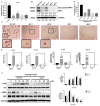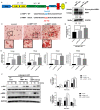Neuropilin 1 (NRP1) Positively Regulates Adipogenic Differentiation in C3H10T1/2 Cells
- PMID: 37108554
- PMCID: PMC10138427
- DOI: 10.3390/ijms24087394
Neuropilin 1 (NRP1) Positively Regulates Adipogenic Differentiation in C3H10T1/2 Cells
Abstract
Neuropilin 1 (NRP1), a non-tyrosine kinase receptor for several ligands, is highly expressed in many kinds of mesenchymal stem cells (MSCs), but its function is poorly understood. In this study, we explored the roles of full-length NRP1 and glycosaminoglycan (GAG)-modifiable NRP1 in adipogenesis in C3H10T1/2 cells. The expression of full-length NRP1 and GAG-modifiable NRP1 increased during adipogenic differentiation in C3H10T1/2 cells. NRP1 knockdown repressed adipogenesis while decreasing the levels of Akt and ERK1/2 phosphorylation. Moreover, the scaffold protein JIP4 was involved in adipogenesis in C3H10T1/2 cells by interacting with NRP1. Furthermore, overexpression of non-GAG-modifiable NRP1 mutant (S612A) greatly promoted adipogenic differentiation, accompanied by upregulation of the phosphorylated Akt and ERK1/2. Taken together, these results indicate that NRP1 is a key regulator that promotes adipogenesis in C3H10T1/2 cells by interacting with JIP4 and activating the Akt and ERK1/2 pathway. Non-GAG-modifiable NRP1 mutant (S612A) accelerates the process of adipogenic differentiation, suggesting that GAG glycosylation is a negative post-translational modification of NRP1 in adipogenic differentiation.
Keywords: adipogenic differentiation; mesenchymal stem cells; neuropilin 1.
Conflict of interest statement
The authors declare no conflict of interest.
Figures






Similar articles
-
NRP1 promotes osteo/odontogenic differentiation via shroom3 in dental pulp stem cells.Biochim Biophys Acta Mol Cell Res. 2024 Oct;1871(7):119795. doi: 10.1016/j.bbamcr.2024.119795. Epub 2024 Jul 20. Biochim Biophys Acta Mol Cell Res. 2024. PMID: 39033931
-
GLP-1RA promotes brown adipogenesis of C3H10T1/2 mesenchymal stem cells via the PI3K-AKT-mTOR signaling pathway.Biochem Biophys Res Commun. 2018 Dec 2;506(4):976-982. doi: 10.1016/j.bbrc.2018.10.197. Epub 2018 Nov 4. Biochem Biophys Res Commun. 2018. PMID: 30404729
-
Hmox1 promotes osteogenic differentiation at the expense of reduced adipogenic differentiation induced by BMP9 in C3H10T1/2 cells.J Cell Biochem. 2018 Jul;119(7):5503-5516. doi: 10.1002/jcb.26714. Epub 2018 Mar 25. J Cell Biochem. 2018. PMID: 29377252
-
Chondroitin sulphate-modified neuropilin 1 is expressed in human tumour cells and modulates 3D invasion in the U87MG human glioblastoma cell line through a p130Cas-mediated pathway.EMBO Rep. 2008 Oct;9(10):983-9. doi: 10.1038/embor.2008.151. Epub 2008 Aug 15. EMBO Rep. 2008. PMID: 18704117 Free PMC article.
-
The Nervous System Development Regulator Neuropilin-1 as a Potential Prognostic Marker and Therapeutic Target in Brain Cancer.Cancers (Basel). 2023 Oct 10;15(20):4922. doi: 10.3390/cancers15204922. Cancers (Basel). 2023. PMID: 37894289 Free PMC article. Review.
Cited by
-
Medium from human iPSC-derived primitive macrophages promotes adult cardiomyocyte proliferation and cardiac regeneration.Nat Commun. 2025 Mar 27;16(1):3012. doi: 10.1038/s41467-025-58301-8. Nat Commun. 2025. PMID: 40148355 Free PMC article.
-
Identification and characterization of structural variants related to meat quality in pigs using chromosome-level genome assemblies.BMC Genomics. 2024 Mar 21;25(1):299. doi: 10.1186/s12864-024-10225-1. BMC Genomics. 2024. PMID: 38515031 Free PMC article.
References
MeSH terms
Substances
Grants and funding
LinkOut - more resources
Full Text Sources
Other Literature Sources
Research Materials
Miscellaneous

